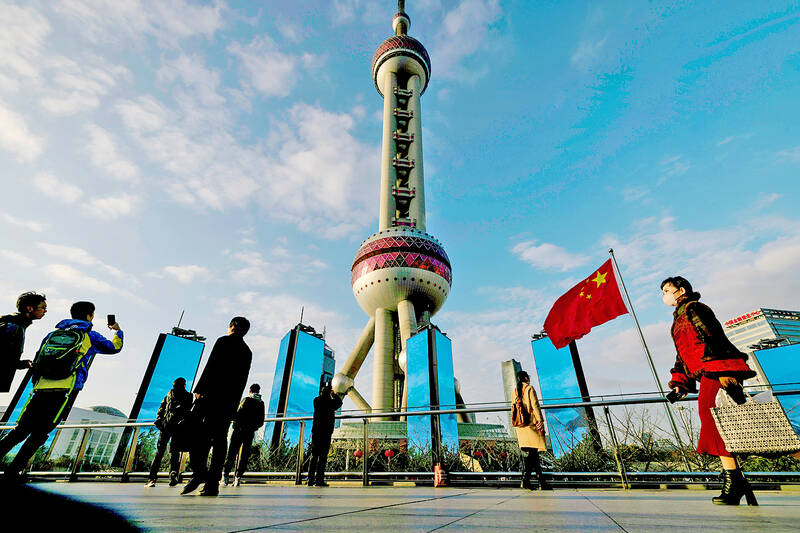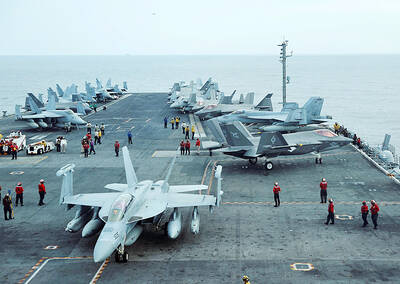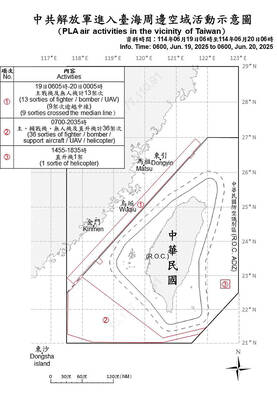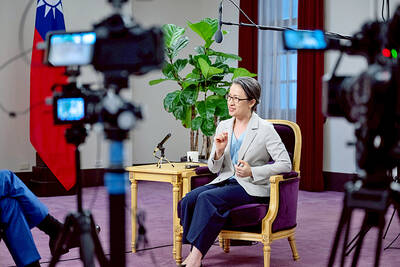There has been a significant generational difference in those who travel to China among Taiwanese over the past 16 years, with younger travelers less likely to visit the country, a breakdown of national travel statistics showed.
Since direct aviation links were opened across the Taiwan Strait in 2008, Taiwanese visited China 38.15 million times as of the end of last year, making it the second-most popular outbound destination for locals after Japan (39.55 million visits), the Tourism Administration said.
People aged 50 to 59 visited China the most, with 9.42 million visits, followed by people aged 40 to 49 with 9.35 million visits.

Photo: EPA-EFE
On the other hand, younger travelers, aged 20 to 29, accounted for 2.9 million visits.
By comparison, people aged 20 to 29 visited Japan 6.55 million times during the same period, or 125 percent more than the visits to China, statistics showed.
High Quality of Travel Association public relations representative Ringo Lee (李奇嶽) said he observed that older generations are more likely to visit China for leisure travel compared with younger Taiwanese.
Part of the reason was the nature of Chinese travel, which emphasizes scenic beauty and history, he said.
“[Younger people] prefer lively, popular, glamorous and shopping-oriented experiences, enjoying food and buying things. They don’t visit temples,” he said.
Young people might think traveling to China is not cool, said Huang Cheng-tsung (黃正聰), an associate professor at Providence University’s Department of Tourism.
“If young people take photos in China and share them, they might not receive positive feedback,” he said.
Cultural affinity also affected people’s choice of destination, Lee and Huang said.
Older generations have a greater understanding of China due to the education they received, resulting in higher interest in the country, they said.
Politics has also factored into travel decisions and perhaps made younger people more reluctant to travel to China over the past few years, Lee said.
After President Tsai Ing-wen (蔡英文) took office, the number of people traveling to China continued to rise, reaching a peak of 4.17 million in 2018.
However, that number began to decline in 2019, particularly in July and August, coinciding with the massive protests in Hong Kong.
Travel to China took a massive hit because of the COVID-19 pandemic and has been extremely slow to rebound, largely because of Taiwan’s continuous ban on group travel to China, Lee said.
When China’s border reopened last year, Taiwanese visited the country 1.76 million times, compared with more than 4 million visits a year before the pandemic, data showed.
Taiwan initially planned to resume organized tours to China in August last year, but later postponed it to February as cross-strait tensions persisted.
However, Beijing had not agreed to allow its tour groups to visit Taiwan, and the government decided once again to ban local tour groups from visiting China in the name of reciprocity.
As a result, while tours scheduled between March 1 and May 31 were able to proceed, those scheduled for after June 1 were canceled.
The policy change was regrettable, Lee said, citing high booking demand, particularly for tours to Xinjiang Province and Inner Mongolia in China.
“Of course, we hope that tourism exchanges between the two sides can be restored as soon as possible,” Lee said, adding that cross-strait tourism accounts for about 40 percent for Taiwan’s aviation and travel sector.
Huang said that even if cross-strait tourism completely reopened, Taiwanese visits to China might only reach about 80 percent of pre-pandemic levels due to political factors.
“China’s stance toward Taiwan has been quite firm in recent years,” Huang said. “Many people may not feel comfortable with this.”

China might accelerate its strategic actions toward Taiwan, the South China Sea and across the first island chain, after the US officially entered a military conflict with Iran, as Beijing would perceive Washington as incapable of fighting a two-front war, a military expert said yesterday. The US’ ongoing conflict with Iran is not merely an act of retaliation or a “delaying tactic,” but a strategic military campaign aimed at dismantling Tehran’s nuclear capabilities and reshaping the regional order in the Middle East, said National Defense University distinguished adjunct lecturer Holmes Liao (廖宏祥), former McDonnell Douglas Aerospace representative in Taiwan. If

TO BE APPEALED: The environment ministry said coal reduction goals had to be reached within two months, which was against the principle of legitimate expectation The Taipei High Administrative Court on Thursday ruled in favor of the Taichung Environmental Protection Bureau in its administrative litigation against the Ministry of Environment for the rescission of a NT$18 million fine (US$609,570) imposed by the bureau on the Taichung Power Plant in 2019 for alleged excess coal power generation. The bureau in November 2019 revised what it said was a “slip of the pen” in the text of the operating permit granted to the plant — which is run by Taiwan Power Co (Taipower) — in October 2017. The permit originally read: “reduce coal use by 40 percent from Jan.

‘SPEY’ REACTION: Beijing said its Eastern Theater Command ‘organized troops to monitor and guard the entire process’ of a Taiwan Strait transit China sent 74 warplanes toward Taiwan between late Thursday and early yesterday, 61 of which crossed the median line in the Taiwan Strait. It was not clear why so many planes were scrambled, said the Ministry of National Defense, which tabulated the flights. The aircraft were sent in two separate tranches, the ministry said. The Ministry of Foreign Affairs on Thursday “confirmed and welcomed” a transit by the British Royal Navy’s HMS Spey, a River-class offshore patrol vessel, through the Taiwan Strait a day earlier. The ship’s transit “once again [reaffirmed the Strait’s] status as international waters,” the foreign ministry said. “Such transits by

Taiwan is doing everything it can to prevent a military conflict with China, including building up asymmetric defense capabilities and fortifying public resilience, Vice President Hsiao Bi-khim (蕭美琴) said in a recent interview. “Everything we are doing is to prevent a conflict from happening, whether it is 2027 or before that or beyond that,” Hsiao told American podcaster Shawn Ryan of the Shawn Ryan Show. She was referring to a timeline cited by several US military and intelligence officials, who said Chinese President Xi Jinping (習近平) had instructed the Chinese People’s Liberation Army to be ready to take military action against Taiwan